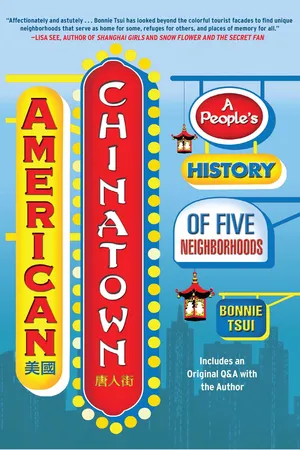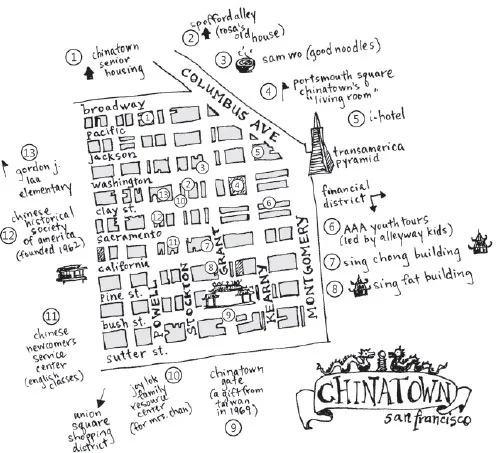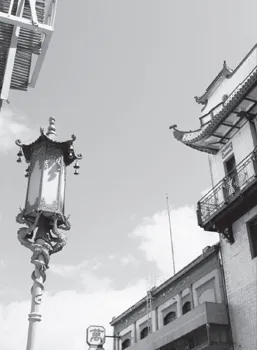Grant Avenue, San Francisco. Bonnie Tsui
On my first visit to the City by the Bay’s famous Chinatown, I was reminded of Disney World.
Here were multilevel pagoda tops, sharply curving eaves, and Orientalized cornices decorating everything from the bank to the school to the McDonald’s. Brightly colored lanterns and flags hung liberally, and trolley cars running down one of its streets added to what seemed to me a “Straight from Old China!” amusement-park air. The big dragon welcome gate at Grant Avenue, the main drag, actually did come from the Far East—a gift from Taiwan—but in 1969, not 1869. No imperial-period importation, but a contemporary of the civil rights era and Woodstock. It was just before the United States under Nixon famously extended the olive branch to Communist China in the 1970s, acknowledging their political position that there was only one China, and that Taiwan was part of that state. But most of Chinatown, comprised of immigrants with memories of escaping the Communist takeover of China to come to the United States in the first place, remained loyal to the Nationalist government that had fled to, and remained in, Taiwan.
It was in that era that my father himself first came to San Francisco’s Chinatown, from Hong Kong, in 1968. The trip was his first to America—indeed, his first experience with an American Chinatown—and when I ask him what he remembers about that time, he says it was the neighborhood’s distinctively “old” look that struck him most.
He wondered how Chinatown, in a supposedly modern America, could seem even older than the oldest parts of Hong Kong’s historic Kowloon district. Shouldn’t an American Chinatown be ultra-urban, with the tall buildings and gleaming, metropolitan feel of his home city’s commercial center? Instead, it was ornamented with the kind of Chinese flourishes that hadn’t been used in China for decades. Plus, it looked run-down, crowded, and dirty. What was it, he wondered, that kept the Chinese neighborhood from looking like all the rest of San Francisco?
The same small, high-density buildings, jumble of sidewalk stalls, and Sinophilic streetscapes that my father saw as a new immigrant in 1968 are what we have come to know as characteristic of San Francisco’s iconic Chinatown. But dig into its history and you’ll find that the “authentic Chinese” look is a fabricated one, its self-stylization actually begun only a century ago, when the 1906 earthquake leveled the original Chinatown and presented an opportunity for city developers to force the relocation of the Chinese American community and claim the valuable real estate that the neighborhood occupied. “Let Us Have No More Chinatowns in Our Cities,” read the Oakland Enquirer on April 23, 1906, five days after the quake hit. It wasn’t until this point that the Chinatown familiar to us came to take shape; the Oriental city of “veritable fairy palaces” was a conscious, East-meets-West attempt by Chinese merchants to change the community’s image from that of a vice-filled slum and ensure its continuing survival as, in part, an attractive tourist draw.
The reading of the physical attributes of this Chinatown, the nation’s oldest, can tell us surprising things about its story. In the same year of my father’s arrival, Chinatown residents were rebelling against the neighborhood establishment for promoting tourism while neglecting social reforms that would benefit the community. The exoticization that saved the neighborhood in the past became fuel for protest; in black-and-white photos of a 1968 Chinatown demonstration, young radicals rejected the old guard with signs that lampooned a dated way of thinking: “KEEP GRANT AVE NARROW, DIRTY, AND QUAINT FOR TOURISTS!” “Looking for an exotic place to live? Come join our community *rats *overcrowding *poverty *roaches” “PRESERVE CHINATOWN’S UNIQUENESS—HIGHEST TB RATES, NO UNIONS, THE MOST SUICIDES, LOWEST WAGES!”
When I began to look into the story behind the neighborhood’s deliberate tourist architecture, and the social currents that led to its subsequent renewal, everyone I asked about it—in this Chinatown and outside of it—pointed to Philip P. Choy.
PHIL CHOY IS an old-timer. Born in Chinatown in 1926 and raised there, he is an architect and historian who, along with fellow Chinese American studies pioneer Him Mark Lai, taught the first college-level Chinese-American history course in the country, in 1969. The reading of the Chinatown skyline to determine what it could reveal about the people’s history within the district was also a perspective of his innovation. Many academics operate at some remove from their subjects, but Choy’s connection is intensely personal.
Throughout his lifetime, he has been a conscious observer of the sweeping changes that have happened in the neighborhood where he grew up. When we met, Choy was, at eighty-one, a calm, well-spoken man with a head of white hair and a mustache to match. Years of teaching have given him a strong, measured way of talking, and he knows his opinions. He is candid with his stories and experiences in Chinatown and as a Chinese American encountering racism over an all-too-recent span of the twentieth century. Together with Lai, his novel accomplishment is to have documented Chinatown and Chinese American history when there was no such discipline. “I’m just plain Phil,” he told me when I visited him. “But I can tell you all about Chinatown and its evolution.”
Choy is an architect by training—he designed and built the modern, light-filled house he lives in today, with his wife, Sarah, about five blocks northwest of Chinatown—but he says his interest has always been in the history of the Chinese in America. It was when civil rights arrived in Chinatown in the sixties that Choy began to take on his most important role, as an interpreter of history. By that time, though he was working in an architecture firm—mostly designing restaurants and homes—and living outside of Chinatown, he had become actively involved with the neighborhood’s Chinese Historical Society, which was founded in 1963.
The physical condition of Chinatown created a context for rebellion to flourish with the community’s youth. Due to more relaxed immigration laws in the 1960s, a flood of new immigrants had begun to populate the area, and a gap had opened up between the conservative old guard and a younger generation who agitated for higher wages, cleaner streets, better schools equipped to educate non-English–speaking kids, and more and better housing for the poor. “They criticized the Chinatown establishment for not confronting the real issues of Chinatown—for maintaining the status quo, maintaining its isolation, and maintaining the decades of ‘well-behaved good Chinese’ who never rocked the boat,” Choy said. “The conservative elements who ran the community for so long looked upon these young people as rabble-rousers who were bringing disgrace to Chinatown.”
Like the rest of the nation, Chinatown was burning for change. And it was 1968—the year of Chinatown protest, when my father observed a blighted, dilapidated neighborhood—that students at San Francisco State College, now San Francisco State University, drew national attention by staging the Third World Student Strike in support of establishing an ethnic studies program there.
A vacuum of knowledge about the ethnic community became painfully apparent. When San Francisco State came calling in the wake of the student strike, to ask if anyone at the historical society would want to teach a class, Choy and Mark Lai realized that they knew things no one else knew about. “For me, it was a moment of enlightenment,” Choy said. “We could help give the students information and a good dose of history, because up until that point, nobody really knew much about the background of the Chinese in America.”
They held classes back to back—the original class syllabus is still heavily referenced today by teachers in the school’s Asian American Studies Department—but nonetheless there was over-enrollment. “That was the period when Chinese American students were angry, but they didn’t know what they were angry about,” Choy said. “They didn’t know why they were second-class citizens. They didn’t know why their parents were so passive—there was a lot of resentment.” In other words, they needed someone to put their lives in the context of something larger than themselves.
Choy’s own life gave him useful perspectives that he could pass on to his students. As a boy growing up in Chinatown in the 1930s, he felt a cloud of insecurity over the area, a feeling of “illegality” that he got from listening to his parents talk. “We had a very common saying in Chinese, m-ho duk joi di faan gwei—‘don’t offend the white people.’ When you were getting into trouble, or when you were not behaving, you were always being admonished not to offend the white people. My father being an illegal immigrant, there was always the possibility of investigations, and they were always afraid.” The 1906 earthquake had destroyed a huge chunk of the city’s birth and immigration records; like hundreds—perhaps thousands—of other “paper sons,” Choy’s father had come into the United States by purchasing false American birth documents. After the quake, Chinese already in the United States could claim citizenship, and they could also claim children born in China as American citizens. These identities, real or false, could be sold to others for a profit. The numbers were impossible to trace, but a 1957 New Yorker article reported that if all claims of burned birth certificates were true, “every Chinese woman living in San Francisco before 1906 had had eight hundred sons.”
Choy himself had only moved out of Chinatown in the mid-1950s, after laws were changed to allow Chinese to buy property outside of Chinatown. He could explain the fears and inaction of a certain Chinatown generation to his students. He could describe the insularity and self-protection of his parents’ generation, a conservative sector of the community that was still afraid to socialize with whites. And he could also go beyond the immediate past and take the long view, contextualizing the life of Chinese America within the larger history of America. That, he says, has always been his goal.
A major perspective of Choy’s on Chinatown has been through its buildings. One of his earliest memories involves borrowing Charles Caldwell Dobie’s San Francisco’s Chinatown from the library; published in 1936, it was one of the first general history books written about Chinatown. Choy admired the pencil illustrations in the volume, and carried the book from street corner to street corner, comparing each drawing to the actual subject. Afterward, he tried his own hand at sketching the houses and schools and stores that populated his daily life.
From the library in his architect’s study, he pulled down a copy of Dobie’s Chinatown and showed me its well-preserved pages. “If you know the buildings, you know the history,” he said, flipping past drawings of the Chinese school he attended as a youth. “We’re always considered foreigners, generation after generation. But look at the evidence. There is a story to be told, and it is that the community of Chinatown has been here since the founding of San Francisco itself.”
IN THE BUILDINGS of Chinatown, Choy sees the social climate in which the modern community took shape. With his background in architecture, Choy brought together under scrutiny the two major characteristics that have established San Francisco Chinatown so firmly in the American imagination: its long history, and the hybrid Sino-American architecture unique to it. The Chinese had been coming to San Francisco in large numbers since 1848, when word of the California Gold Rush reached Guangdong—a region that was being ravaged by civil war, drought, and famine. They called California gum saan: “gold mountain.” In the following decades, Chinese immigrants, mostly Cantonese male peasants from the countryside, settled in the United States by the thousands to build the railroad and to work as farmers. By 1870, there were about 63,000 Chinese in America, more than three-quarters of them in California. Many had formed powerful family and business associations to protect their interests and help newcomers settle into the country. Despite these facts, Choy has written, visitors to Chinatown today continue to see Chinatown as an “unassimilated foreign community” where traditional culture and architecture dominate and are “mere transplants” from China. In their haste to view Chinatown as an exotic oasis, Choy says, most fail to understand the true history of the community that is bound up in its buildings.
I only have to think back to my most recent visit to Chinatown—cameras clicking on every block, slow-walking tourists showing a pervasive fascination with the colorful, festive atmosphere—to see his point. Hundreds of thousands of visitors come to Chinatown every year seeking authenticity and cultural flavor. As Choy has written, these exotics take on a different meaning upon the discovery that the appearance of Chinatown today is due in large part to Chinese merchants who, after the 1906 earthquake, paid white architects to come up with an Oriental look that would be appealing and acceptable to a general public that had come to view the Chinese with racist eyes.
In his telling of Chinatown, Choy first points to the fact that Chinatown before the quake had a largely Western appearance. Consult pre-1906 drawings, photos, and literature, he says, and brick houses and Italianate Victorian facades and balconies dominate. When I researched old images of San Francisco Chinatown, I found street scenes of wood-shingled residences with awnings, cobbled streets, and horse-drawn carriages, discernibly Chinese only in decorative signs and details. After white residents moved out of Chinatown in favor of newer, more affluent neighborhoods in San Francisco, the Chinese occupied their vacated buildings. Architecturally, Chinatown of the latter nineteenth century was a typical American frontier settlement, only with Chinese characters.
But even before the earthquake, Choy says, many of the Chinese wanted to change their image. By 1854, California laws had been put in place in to ensure that violence against Chinese immigrants—which was already on the uptick—could not be prosecuted in court. In 1882, the Chinese Exclusion Act was passed—the first U.S. law ever to ban immigration based on race or nationality—and it would not be repealed until 1943, when China became an ally to the United States in World War II. That period became known as the exclusion era. Though the law exempted merchants, travelers, students, and those born in the United States, most Chinese left in America were essentially in limbo: they couldn’t vote, they couldn’t reunite with their families, and their rights were not protected. Legal residents could not become citizens. Racism was rampant. At the time of the quake, the immoral Chinatown presented by anti-Chinese forces—the one filled with gambling, prostitution, opium dens, and cheap labor competition—needed to be replaced by a better face, and fast, since the San Francisco Board of Supervisors had increasingly threatened the community with forcible removal. The opening of the earth, at five twelve A.M. on April 18, 1906, became the moment for reinvention. Soon afterward, the specifics of Chinatown’s new construction were determined by Chinese merchants Look Tin Eli and Tong Bong, who hired the architect-engineer team of T. Patterson Ross and A. W. Burgren to build the Sing Fat Co. building and the Sing Chong Co. Chinese bazaar.
“From an architectural point of view, the buildings are mediocre,” Choy says. “What was the first thing they thought of in Chinese architecture? The pagoda. So immediately that becomes the model for the building. They turned up roofs, made the curlicues, and so on. Basically they were taking a lot of standard architectural ornaments and creating a new vernacular, neither Chinese nor American, neither East nor West. It’s just a figment of the imagination of a white architect. But what’s important is that it tells us a story of what happened, why these buildings came about, and it was because we were promoting our ethnicity to please the white man at the time. It was self-preservation.”
One weekday afternoon, I walked to the intersection of Grant Avenue and California Street. It’s a corner where people in S.U.V.s cruise by and hang out the window to snap photos of the landmark Sing Fat and Sing Chong buildings, those two edifices that exemplify the reinvention of Chinatown at the turn of the twentieth century. The pagoda-stacked Sing Chong first housed a dry goods shop; the ground floor has since been home to a McDonald’s and is now the Chinatown Food Court. Next door, the Asian Image Boutique sells art. Across the street, the Sing Fat is a plain brown brick building with green stone detailing and a plopped-on pagoda cap painted in red, green, and yellow. Its retail windows trumpet “Fine Jewelry Everything 70% Off!” On this main tourist drag, traffic is predominantly non-Chinese: groups of sightseers wait for the cable car to come pick them up, and other visitors sit on the steps of Old St. Mary’s Ch...


